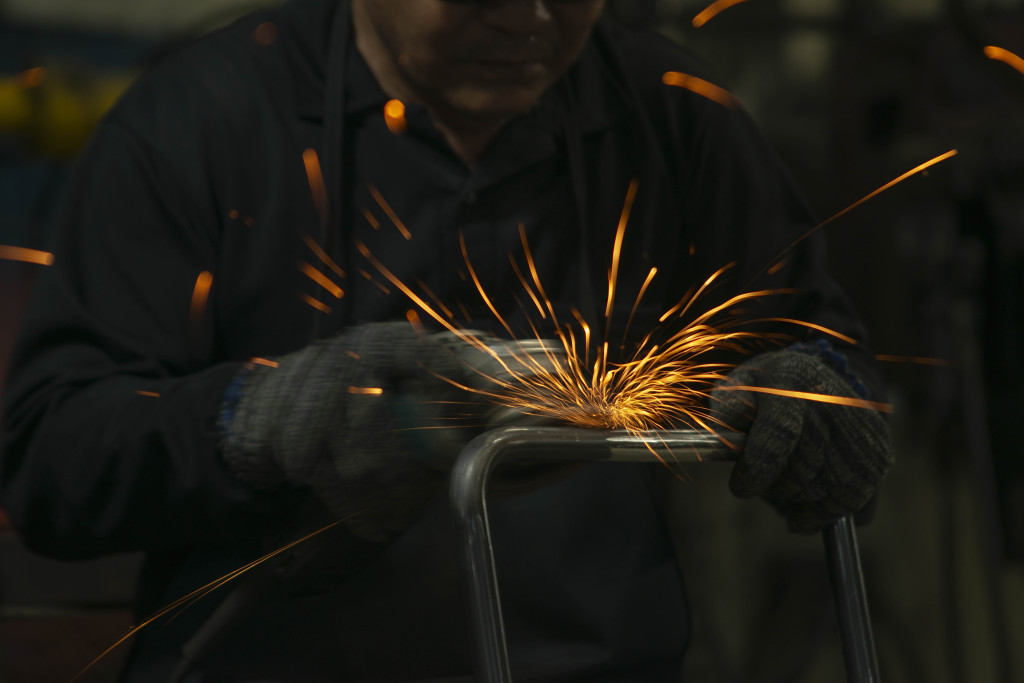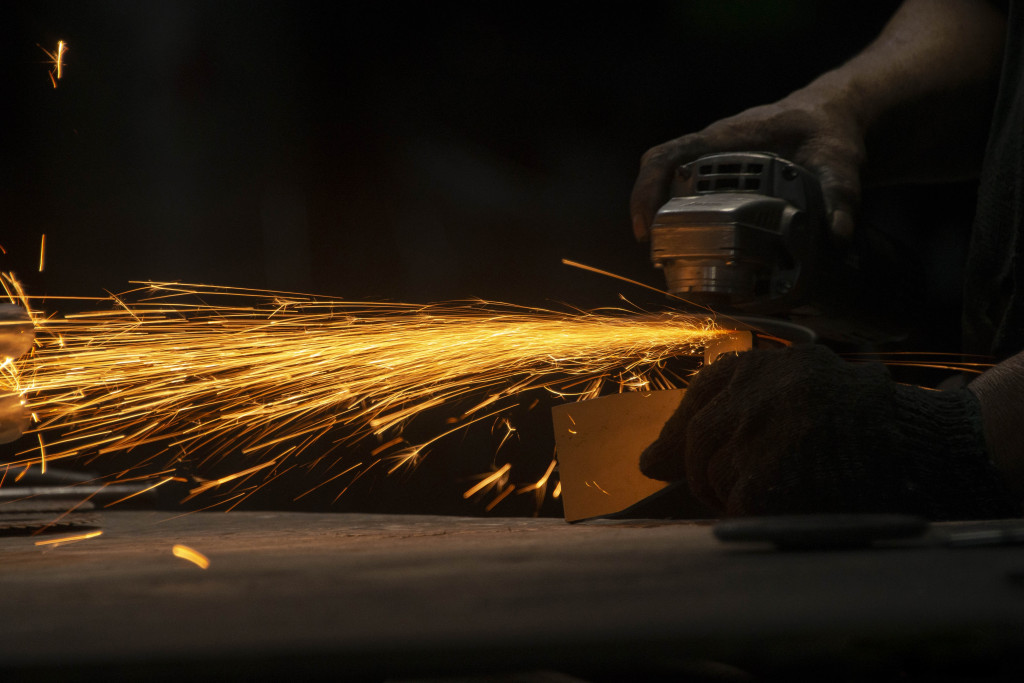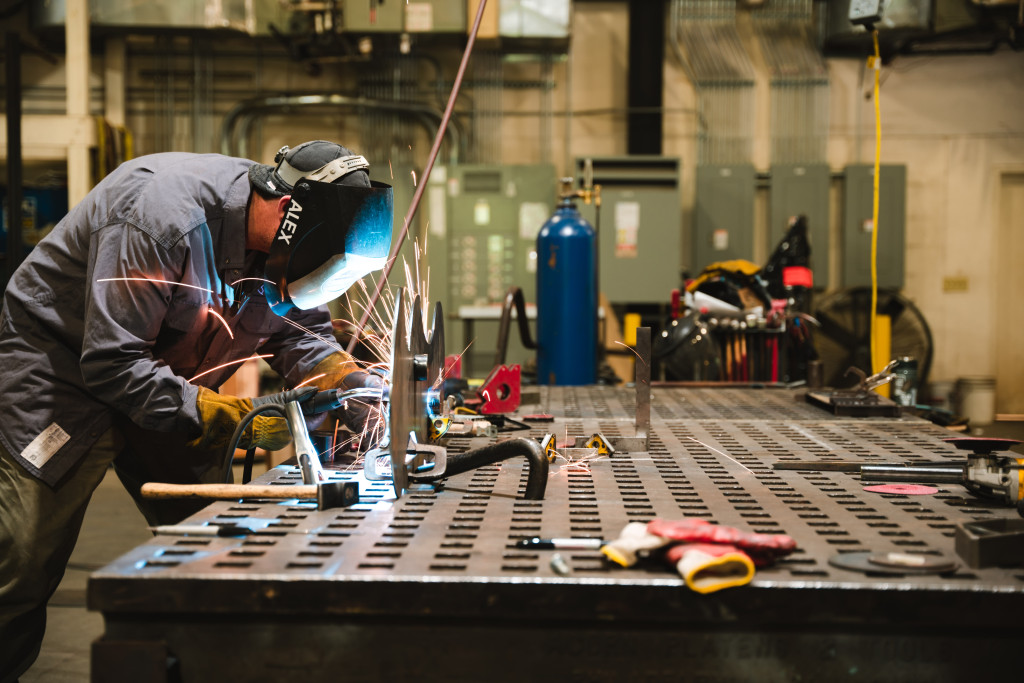Bench Grinders in Metalworking are an essential tool for any metalworker. With their versatile functionality, bench grinders have become a go-to option for tasks such as sharpening, buffing, and shaping metal objects. Whether you are a professional metalworker or a DIY enthusiast, a bench grinder will undoubtedly prove to be a valuable addition to your workshop. Let’s explore the various features and uses of bench grinders in metalworking and discover how they can enhance your crafting experience. So, grab your safety goggles and get ready to unleash your creativity with the power of bench grinders!
Safety Precautions
When it comes to using a bench grinder, safety should always be your top priority. The following safety precautions are essential to ensure a safe and accident-free working environment.
Eye protection
Protecting your eyes is crucial when operating a bench grinder. Flying sparks, debris, and even fragments of the workpiece can pose a serious risk to your eyesight. Always wear safety glasses or goggles that are designed to provide adequate protection against impact and debris.
Face protection
In addition to eye protection, it is also recommended to wear a face shield when using a bench grinder. This will provide an extra layer of protection for your face, especially when working with larger workpieces or when performing tasks that generate a significant amount of sparks.
Ear protection
Bench grinders can be noisy machines, and prolonged exposure to high levels of noise can lead to hearing damage. To protect your ears, it is recommended to wear earplugs or earmuffs while using a bench grinder, especially if you will be using it for extended periods.
Hand protection
Your hands are at risk of coming into contact with the grinding wheel or other moving parts of the bench grinder. To prevent injuries, it is vital to wear thick, heavy-duty gloves that can provide adequate protection against cuts, abrasions, and burns.
Workshop environment
The overall workshop environment plays a crucial role in ensuring safety while using a bench grinder. Keep your work area clean and well-organized, free from clutter or any other potential hazards. Make sure there is sufficient lighting to clearly see your work, and ensure that the surrounding area is clear of obstructions.
Always read the manual
Before using a bench grinder, it is essential to thoroughly read and understand the manufacturer’s manual. The manual will provide you with specific instructions on how to operate the bench grinder safely and effectively. Familiarize yourself with the safety guidelines, recommended usage, and maintenance procedures outlined in the manual.
Types of Bench Grinders
When it comes to choosing a bench grinder, there are several types to consider, each with its own unique features and advantages. Understanding these different types will help you select the one that best suits your specific needs and requirements.
Standard bench grinder
The standard bench grinder is the most basic type available. It typically features two grinding wheels, one on each side, and a motor that powers both wheels simultaneously. Standard bench grinders are ideal for general-purpose grinding tasks and are suitable for both metalworking and woodworking applications.
Variable speed bench grinder
A variable speed bench grinder allows you to adjust the speed of the grinding wheels to match the requirements of your specific task. This type of bench grinder is particularly useful when you need to work on delicate or precision workpieces that require more control over the grinding speed.
Bench grinder with wire wheel
A bench grinder with a wire wheel attachment is specially designed for tasks that involve cleaning, deburring, and surface preparation. The wire wheel is made up of stiff wire bristles that effectively remove rust, paint, and other surface contaminants from metal. This type of bench grinder is commonly used in automotive, fabrication, and restoration work.
Bench grinder with polishing wheel
If you require a bench grinder for polishing or buffing metal, a bench grinder with a polishing wheel is the ideal choice. The polishing wheel is made up of soft, fine abrasive material that can achieve a high level of shine and smoothness on metal surfaces. This type of bench grinder is commonly used in jewelry making, metal crafting, and other precision polishing applications.
Bench grinder with belt sander
A bench grinder with a belt sander attachment offers the versatility of both grinding and sanding functions. The belt sander attachment allows you to tackle a wide range of tasks, including shaping, smoothing, and even some light material removal. This type of bench grinder is particularly useful for woodworking projects or when working with soft metals.

Factors to Consider Before Purchasing
Before purchasing a bench grinder, there are several factors that you should take into consideration to ensure that you choose a model that meets your specific needs and preferences.
Motor power and speed
The motor power and speed are crucial factors to consider when selecting a bench grinder. Higher horsepower motors provide more power and can handle heavier-duty grinding tasks. Additionally, variable speed control allows you to adjust the grinding speed based on the specific requirements of your task.
Wheel size and materials
The size and materials of the grinding wheels are important considerations. Wheel size determines the maximum size of workpiece that can be accommodated, while the materials of the wheels determine their durability and suitability for different tasks. Common wheel materials include aluminum oxide, silicon carbide, and diamond.
Adjustability and versatility
Consider the adjustability and versatility features offered by the bench grinder. Adjustable tool rests and work rests allow you to achieve precise angles and positions for your grinding tasks. Additionally, some bench grinders offer the flexibility of rotating or tilting the grinding wheels for added convenience and versatility.
Ease of use and control
Choose a bench grinder that is user-friendly and easy to operate. Look for features such as intuitive controls, clear labeling, and ergonomic design that ensures comfortable handling during extended use. A bench grinder with easy access to the controls and adjustment mechanisms will allow you to make quick and efficient changes as needed.
Durability and build quality
Investing in a bench grinder that is built to last is essential. Look for models that are constructed using high-quality materials and have a sturdy build. Check for features such as solid construction, heavy-duty components, and reliable motors to ensure that your bench grinder will withstand the rigors of regular use.
Setting Up a Bench Grinder
Setting up your bench grinder properly is essential for achieving accurate and safe grinding results. Follow these steps to ensure that you have a well-prepared workspace before you start using your bench grinder.
Choosing the right location
Select a location in your workshop that provides ample space for your bench grinder and allows for easy access and maneuverability. Ensure that the location is stable and that there are no obstructions or hazards nearby. If possible, position your bench grinder close to a workbench or sturdy surface for added stability and support.
Securing the grinder
To prevent the bench grinder from moving or vibrating during use, it is important to secure it firmly in place. Most bench grinders come with mounting holes on the base, which allow you to attach the grinder securely to a workbench or other stable surface. Use appropriate fasteners and ensure that the bench grinder is tightly secured before operation.
Proper electrical connections
Before plugging in your bench grinder, ensure that you have a reliable power source and that it is compatible with the voltage requirements of the grinder. Use a grounded outlet and check the power cord for any damages or fraying. Avoid using extension cords, as they may not provide sufficient power and can pose a safety hazard.
Organizing work area for convenience
Arrange your work area in a way that promotes convenience and efficiency. Keep your grinding accessories, safety equipment, and other essential tools within easy reach. Consider setting up a dedicated tool rest or support system for your bench grinder that allows you to position and secure your workpiece effectively.

Using the Bench Grinder
Using a bench grinder properly requires proper technique and knowledge of the different components and settings. Follow these steps to ensure safe and effective use of your bench grinder.
Dressing the grinding wheel
Before using your bench grinder for the first time or after extended use, it is important to dress the grinding wheels. Wheel dressing involves removing any debris, old abrasive particles, or glazing on the surface of the wheels. This process helps to maintain the effectiveness and performance of the wheels and ensures accurate grinding results.
Adjusting the tool rest
Proper adjustment of the tool rest is crucial for achieving accurate and consistent grinding results. The tool rest should be positioned at a distance that allows you to maintain proper control and stability while grinding. Ensure that the tool rest is securely tightened and parallel to the grinding wheel for optimal support.
Grinding techniques and angles
When grinding on your bench grinder, it is important to use the correct techniques and angles for different tasks. For general-purpose grinding, maintain a steady and controlled movement of the workpiece across the grinding wheel. Avoid applying excessive pressure, as this can result in overheating and damage to the wheel. When grinding beveled edges or profiles, adjust the tool rest to the desired angle and maintain a consistent grinding motion.
Using different wheels for different tasks
To maximize the versatility of your bench grinder, consider using different wheels for different tasks. Change the grinding wheels based on the material and requirements of the workpiece. For example, use a finer grit wheel for polishing or buffing and a coarser grit wheel for heavy material removal or shaping. Be sure to follow the manufacturer’s guidelines and recommendations for installing and using different types of wheels.
Maintaining and Caring for a Bench Grinder
Regular maintenance and proper care are essential for keeping your bench grinder in good working condition and extending its lifespan. Follow these guidelines to ensure that your bench grinder performs optimally and lasts for years to come.
Regular cleaning and inspection
Clean your bench grinder regularly to remove any accumulated debris, dust, or grinding residue. Turn off the grinder and unplug it from the power source before cleaning. Use a brush or compressed air to remove loose particles from the grinding wheels, tool rest, and other components. Inspect the grinding wheels for any signs of wear or damage, and replace them as needed.
Replacing worn-out parts
Over time, certain parts of your bench grinder may become worn-out or damaged. It is important to regularly inspect these parts and replace them as needed to ensure optimal performance and safety. Common parts that may require replacement include grinding wheels, tool rests, safety shields, and electrical components. Consult the manufacturer’s manual for specific instructions on replacing parts and ensure that you use compatible and high-quality replacements.
Proper storage and maintenance
When not in use, store your bench grinder in a clean and dry environment to protect it from dust, moisture, and other potential contaminants. Cover the grinder with a dust cover or use a storage case to prevent damage or corrosion. Follow the manufacturer’s recommendations for periodic maintenance, such as lubrication or motor servicing, to keep your bench grinder in top condition.

Common Mistakes to Avoid
To ensure safe and efficient use of your bench grinder, it is important to avoid the following common mistakes:
Applying excessive pressure
Applying excessive pressure while grinding can result in overheating and damage to the grinding wheel. Use a light and controlled touch when grinding, allowing the wheel to do the work. Applying too much pressure can also increase the risk of accidents, as the workpiece may be difficult to control.
Overheating the tool
Allowing the tool or workpiece to overheat during grinding can cause damage to both the tool and the workpiece. Overheating can result from excessive pressure, inadequate cooling, or prolonged grinding in one area. Pay attention to the temperature of the tool and workpiece, and take breaks as needed to allow for cooling.
Using incorrect wheel for the material
Using the wrong type of grinding wheel for the material you are working with can result in ineffective grinding and potential damage to the wheel. Different materials require different types of wheels with specific abrasive properties. Refer to the manufacturer’s recommendations and guidelines for selecting the appropriate wheel for your specific task.
Ignoring safety precautions
Neglecting to follow safety precautions can lead to serious accidents and injuries. Always wear appropriate safety gear, such as eye protection, face shields, ear protection, and gloves, when operating a bench grinder. Ensure that the work area is clean and well-organized, and always read and follow the manufacturer’s safety guidelines.
Applications of Bench Grinders
Bench grinders find a wide range of applications in metalworking and other related industries. Some of the common applications include:
Sharpening cutting tools
Bench grinders are commonly used for sharpening various cutting tools, such as chisels, knives, drill bits, and saw blades. The abrasive wheels of the bench grinder provide the necessary precision and control to achieve a sharp and durable cutting edge.
Removing rust and paint
Bench grinders with wire wheel attachments are ideal for removing rust, paint, and other surface coatings from metalwork. The wire bristles effectively strip away the unwanted coatings, leaving a clean and smooth surface ready for further processing or finishing.
Deburring and shaping metal
Metalwork often requires deburring and shaping to remove rough edges and achieve the desired shape or profile. Bench grinders provide a fast and efficient way to perform these tasks, allowing you to smooth out rough edges and contours, enhancing the overall quality and appearance of the workpiece.
Polishing and buffing metal
For achieving a high level of shine and smoothness on metal surfaces, bench grinders with polishing wheel attachments are indispensable. The soft, fine abrasive material of the polishing wheel helps to bring out the luster and mirror-like finish on various metalwork, such as jewelry, decorative items, or metal components.
Improving Bench Grinder Performance
To enhance the performance and capabilities of your bench grinder, consider the following improvement options:
Upgrading grinding wheels
Investing in high-quality grinding wheels can significantly improve the performance and efficiency of your bench grinder. Higher-quality abrasive materials and designs can offer better durability, faster material removal, and improved grinding results.
Using jigs and guides
Jigs and guides can enhance the accuracy and precision of your grinding tasks. These accessories provide support and guidance for the workpiece, ensuring consistent grinding angles and achieving desired results. Using jigs and guides can help you achieve professional-grade grinding outcomes.
Adding cooling systems
Heat buildup during grinding can affect the efficiency and effectiveness of your bench grinder. Adding cooling systems, such as water baths, to your bench grinder can help dissipate heat, prolonging the life of the grinding wheels and preventing overheating of the workpiece.
Enhancing vibration control
Vibration is a common issue when using bench grinders, and excessive vibration can affect the quality of your grinding outcomes. Consider adding vibration-damping materials or mounts to your bench grinder to reduce vibrations and increase stability during operation.
Choosing the Right Accessories
To further enhance the functionality of your bench grinder, consider adding the following accessories:
Grinding wheel dresser
A grinding wheel dresser is a handy tool that helps to maintain the shape and cleanliness of your grinding wheels. It removes any embedded particles, glazing, or debris from the wheel surface, ensuring consistent and effective grinding results.
Tool rest and support
A quality tool rest and support system improves the stability and control of your bench grinder. It provides a secure platform for the workpiece, allowing you to achieve consistent angles and positions. Look for adjustable tool rest options that can accommodate different workpiece sizes and shapes.
Wire wheel brush
A wire wheel brush is a valuable accessory for removing rust, paint, and other surface coatings from metalwork. It quickly strips away the unwanted coatings, saving you time and effort. Ensure that the wire wheel brush is compatible with your bench grinder and offers the appropriate sturdiness and abrasive properties for your task.
Polishing compounds and buffing wheels
If you frequently perform polishing or buffing tasks, investing in high-quality polishing compounds and buffing wheels is a must. Different compounds and wheels offer varying levels of shine and abrasiveness, allowing you to achieve the desired finish on your metalwork.
By following the safety precautions, understanding the different types of bench grinders, considering various factors before purchasing, properly setting up the grinder, and using it correctly, you can ensure safe and effective performance. Additionally, by maintaining and caring for your bench grinder, avoiding common mistakes, and utilizing the wide range of applications and improvement options, you can optimize the performance and versatility of your bench grinder in metalworking and related tasks. Remember to choose the right accessories to further enhance the capabilities of your bench grinder and achieve professional-grade results.



